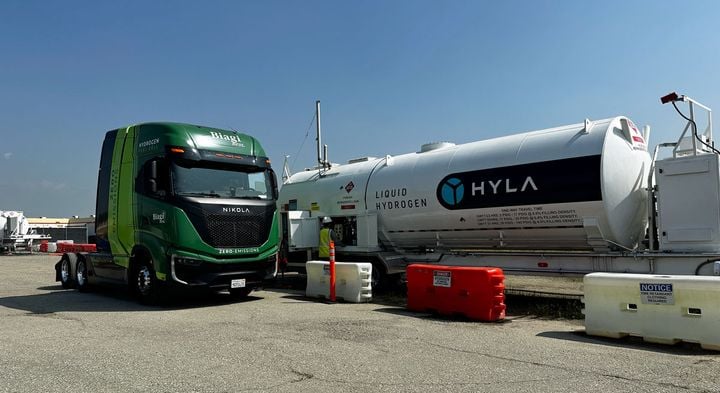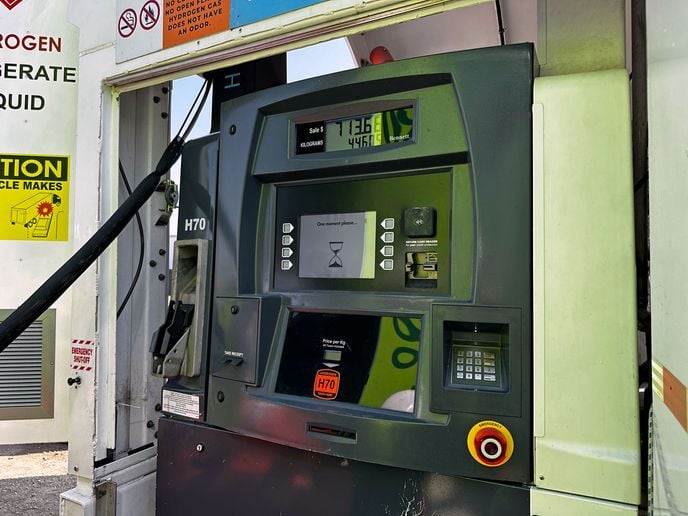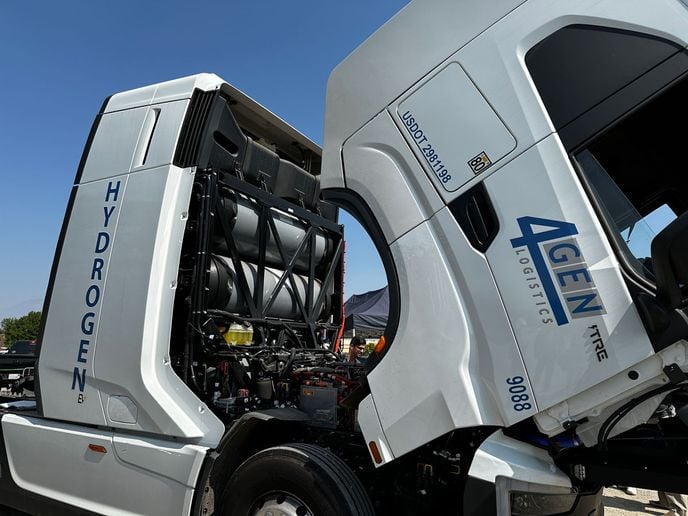Trucker Access › Forums › Diesel News › Nikola’s Hydrogen-Truck Fueling Strategy – Fuel Smarts
- This topic has 0 replies, 1 voice, and was last updated 11 months, 2 weeks ago by
 EazyRiDer66.
EazyRiDer66.
-
AuthorPosts
-
May 8, 2024 at 7:15 am #18977
 EazyRiDer66Keymaster
EazyRiDer66Keymaster

Biago Bros. was one of the fleets on hand for the opening ceremony of Nikola’s hydrogen fueling station.
Nikola’s Hyla energy brand is using modular hydrogen refueling stations to help bridge the chicken-and-egg gap between supply and demand for fuel-cell-electric trucks.
Hyla, announced in early 2023, is a brand devoted to procuring, producing, distributing and dispensing hydrogen to fuel its zero-emissions trucks — and those of other truck makers.
In February, Nikola opened its first high-pressure hydrogen refueling station. Located in Ontario, California, it’s right across from the Ontario airport. Flying in to that airport, you can see a carpet of warehouses and distribution centers surrounded by trailers and trucks, a market for zero-emission trucks as state mandates kick into gear.
The modular station will be capable of fueling up to 40 Nikola FCEV Class 8 trucks daily. It’s part of Nikola’s plan to develop up to nine refueling solutions set to be completed by mid-2024, with 14 total refueling solutions to be operational by the end of the year.
Nikola will provide 24/7 support with on-site “Hyla ambassadors” and technicians.
Hyla’s Hydrogen EcoSystem Strategy
In an interview at the grand opening celebration of the Ontario Hyla facility, Ole Hoefelmann, president of Nikola Energy, explained the importance of the modular strategy in solving the chicken-and-egg problem of investing in alternative fueling facilities.
“Ultimately what you’re looking for is that people build permanent stations,” he said. “This [facility] is not a solution for 10 years.”
The challenge in building permanent hydrogen fueling stations is the chicken-and-the-egg question. It’s not profitable for a developer to invest in a hydrogen fueling facility if there aren’t enough customers to support it. But trucking companies won’t invest in hydrogen trucks unless there’s a way to fuel them.
“What we’ve done is we’ve taken that conversation off the table,” Hoefelmann said.
These modular stations can help bring the permanent stations to fruition, he explained. Hyla can bring in the modular stations and install them around where the permanent station is being built, building density and building demand.
One of Hyla’s modular systems can fuel 50 to 70 trucks a day, he explained. With three of them, that’s capacity for 150 to 200 trucks. Hyla can work to bring in fleet customers that will use those modular stations. By the time the permanent station is ready to go, there will be a customer base ready.
“When the permanent station is ready to go, I transfer the fleets over, the customer base, and I remove my modular fuelers and go to the next site that I’m developing.”

The Ontario station will be capable of fueling up to 40 Nikola hydrogen fuel cell electric Class 8 trucks daily.
Asked about whether hydrogen could be delivered via pipeline similar to natural gas, Hoefelmann said that even with permanent stations, it’s unclear whether that is realistic.
“Today, the solution still is liquid deliveries into liquid trailers,” he says, and even permanent stations are likely to have liquid deliveries, he said.
But the advantage of hydrogen in liquid form, he said, is that the hydrogen can be trucked in from various locations. That offers flexibility on where hydrogen fueling stations can be built as well as where the hydrogen comes from.
Where Does the Hydrogen Come From?
One of the criticisms of hydrogen as a transport fuel has been that the production of hydrogen itself can be a source of pollution and greenhouse gases. And that is something that Hyla is working to address.
“There’s an ecosystem that has been built by the industrial gas companies,” Hoefelmann explains. “They have two kinds of systems that they build. One is large scale hydrogen production for like a refinery. So that’s a dedicated plant, tied to one customer or on a pipeline.
“Then you have an ecosystem that was built around what’s called the merchant market. So this is where you take hydrogen either in gaseous form and put it in a tube trailer and deliver it, or you liquefy it and you deliver it.”
In this legacy hydrogen system, he said, the feedstock is natural gas, which has a higher carbon intensity. This is often referred to as “gray” hydrogen. The quest is for “green” hydrogen, created from renewable energy sources.
Two or three years ago, he says, “there was a lot of hype around industrial green hydrogen, and those were really the growth markets.”
That has slowed down, he says, and new project developers are looking at mobility.
“They come and talk to Nikola and say, when your trucks coming, how much volume do you need? And our discussion with them is, what is your CI? [Carbon intensity]? How are you helping us help our customers in the end meet what they need to get to? And then also, what is the ultimate cost for this CI indicator that I’m able to achieve?”
During those discussions, Hyla asks project developers about the source of the hydrogen. It is an electrolyzer project? Is it using renewable sources such as manure?
“There’s all kinds of things out there that are looking to reduce CI, which then ultimately allows us to reduce the total cost to dispense the hydrogen.”
High Prices a Challenge in Adopting Hydrogen Fuel
The price of hydrogen fuel is a concern. Prices have been rising over the past two years, and estimates are that it currently could cost three times as much to fill up a truck as diesel. Other FCEV truck makers have said hydrogen needs to be priced closer to $10 per kilogram rather than the $25 plus it has been recently.
Asked about the problems with high prices, Hoefelmann said, “I think there’s a supply and demand question overall. And sometimes when people say they can get hydrogen cheaper somewhere else, when you start asking the questions, what kind of hydrogen is it, what pressure is it, is it liquid, can you deliver it, things start adding up.
“So when you look at the hydrogen cost, you have the cost to produce, you have the cost to liquefy, you have the cost to deliver, and the cost to dispense it.
“I think the market mechanisms that we have today in California in the light-duty market are not necessarily reflective of we’re trying to do on heavy-duty,” he said.

4 Gen Logistics is one of the fleets looking at incorporating fuel-cell-electric trucks.
One challenge in that supply and demand equation is that trucking is not the only industry using hydrogen.
“There’s a market price today that exists when those molecules get sold to other applications, like the electronics industry or the steel industry, that we kind of compete with today —because the infrastructure was built for that market,” Hoefelmann said.
“What we’re trying to do here is work with other companies to build new capacity that does two things,” he explained. It gets out of that cost structure and allows the application of various “green” incentives.
Will Total Cost of Ownership Outweigh High Price of Hydrogen?
“If you look at that value chain that talks about production, distribution, dispensing… seven years ago, we were all waiting for heavy-duty to come to help bring their costs down and allow us to bring the technology at a competitive price for the operator.
“I think the discussion still needs to be more mature around TCO.”
Christian Appel, global head of Nikola’s product and programs, stressed during the Ontario interview that it’s not just the price of the hydrogen itself that needs to be considered — it’s also total cost of ownership.
California-based Biagi Bros., which recently completed a two-month trial of a Nikola FCEV and had a truck at the Ontario event, told the Wall Street Journal that because the FCEV has longer range and a quick refueling time, his drivers got twice as much work out of the truck each day compared with battery-electric trucks.
Chris Brown, associate publisher of Bobit brands Automotive Fleet, Auto Rental News, and Fleet Forward, contributed to this story.
-
AuthorPosts
- You must be logged in to reply to this topic.